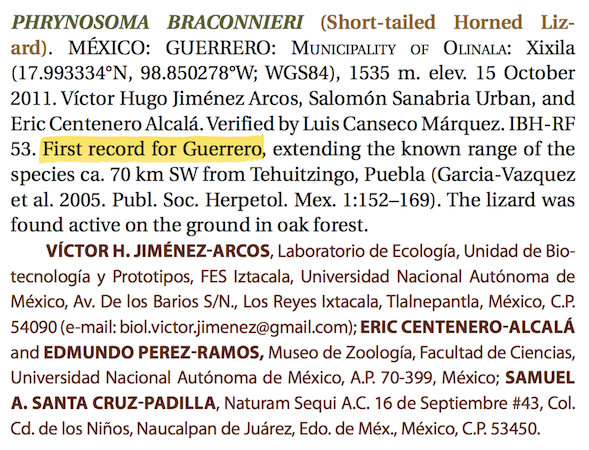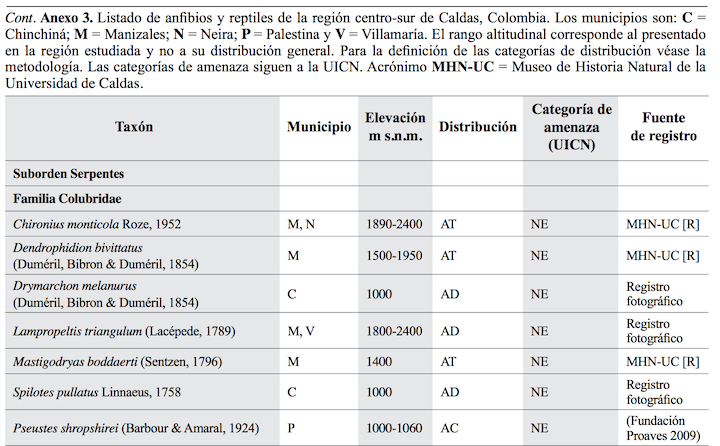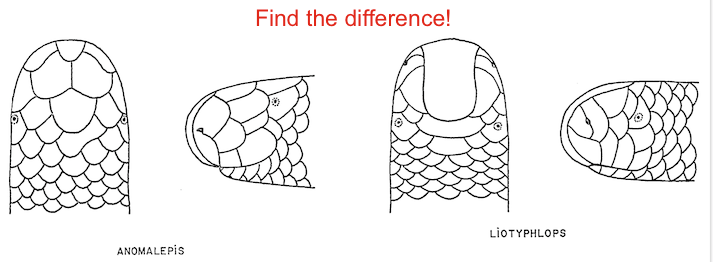The Reptile Database in Teaching
In the exercises below students will not only learn how information is curated from the published literature but actually do it themselves. They will learn how to find out what is online and what is not, how to distinguish between reliable sources and unreliable sources, and then submit their findings to the Reptile Database.
Exercise 1: Curate
distribution data from scientific papers.
The student will receive one or more original “Geographic Distribution” notes from Herpetological Review, e.g. from HR 45 (3): 463 (2014):

(please request HR notes or other literature). They will have to identify the novel information by comparing it to the Reptile Database entry of Phrynosoma braconnieri, which currently (Oct 2014) only lists the Mexican states of Puebla and Oaxaca. The student will then submit this finding to his/her instructor or directly to the Reptile Database (using the Feedback link at the bottom of the aforementioned page), e.g. in this format:
Species: Phrynosoma braconnieri
New locality: Guerrero, Mexico, 17.993334°N, 98.850278°W; WGS84), 1535 m. elev.
Type of information: new state record
Reference: JIMÉNEZ-ARCOS et al. 2014, HR 45 (3): 463
Reptile Database update needed: yes
Alternatively, if more than a few students get involved, we will set up a Google Spreadsheet or the like for easy data submission.
Right now, the Reptile Database does not collect county records, but we are planning to do so soon. We are coordinating with HR how to database such information.
Exercise 2: Compare
checklists to data in the database.
This is somewhat different from the Exercise 1. Here the student gets a checklist (or similar paper with many species). He or she then has to compare that list to a list retrieved from the Reptile Database. For example, this paper
Rojas-Morales, Julián Andrés, Héctor Fabio Arias-Monsalve y Gustavo A. González-Durán 2014
Anibios y reptiles de la región centro-sur del departamento de Caldas, Colombia.
Biota Colombiana 15 (1): 73-93
contains this table:

The student has to search the database for distribution = "Caldas Colombia" (or "Colombia" for comparison) and find those species that do not have "caldas" in their distribution field. These species should then be noted in a table and submitted to the instructor (and the Reptile Database). In fact, in such cases, it would be even better if the student prepared a table listing all species for Caldas, pointing out which ones are already reported from Caldas in the database and which ones are not.
Exercise
3: Find historical literature online
One goal of the Reptile Database is to make the original herpetological literature available by linking the species entries to online resources such as the Biodiversity Heritage Library (BHL). Although we have linked thousands of papers, there are still many that are not linked yet. This is difficult to automate but students can help to do that.
Students will be given a list of historical papers or books and asked to find them in the BHL. While we may have looked for that particular publication at some point, there is a good chance that it has been added in the meantime, given that the BHL continually adds new material. We have currently (October 2014) more than 1,200 citations that have been published before 1923 (see this Excel spreadsheet for a list) which is the copyright cut-off date for the BHL; these publications are not available online through the Reptile Database. For instance,
Annandale, Nelson 1906
Notes on the fauna of a desert tract in southern India. Part. I. Batrachians and reptiles, with remarks on the reptiles of the desert region of the North-West Frontier.
Mem asiatic Soc Bengal Calcutta 1: 183-202
http://www.biodiversitylibrary.org/bibliography/65764
If a student finds such a resource he is asked to submit this information to his/her instructor or to the Reptile Database (using the Feedback link on each species page):
Reference: Annandale, Nelson 1906, Mem asiatic Soc Bengal Calcutta 1: 183-202 (or complete reference, or reference # as given in spreadsheet)
Additional task: for many references the Reptile Database has only links to the journal but NOT the actual article page. For example, most articles published in the Annals and Magazine of Natural History are only linked to the journal page but not their article pages within the journal. Finally, many citations do not have titles or miss other bibliographic information. If students find such cases and provide the missing data, that should be rewarded by bonus points!
Other resources beside the Biodiversity Heritage Library. While the BH is the most prominent resource for historical biodiversity literature, there are many others, such as the national libraries or France or Germany, or the Europeana. Others can be found in Google Books or elsewhere online. It is an important adacemic skill to find information and students should learn to be creative to find the resources they need. So, teach them to search out of the box!
Exercise 4: Find geographic coordinates for localities
Most type localities do not have geographic coordinates. Students can contribute a great deal to find them. Here is how:
1. Open a species entry and locate the type locality. For example, the type locality of Abronia is "Sierra Atravesada, north of Niltepec, between Cerro Atravesada and Sierra Madre, Oaxaca, Mexico, elevation probably between 2500 and 4500 feet".
2. Find that locality using Google Maps. This is not always straightforward. Sometimes a student has to do more research such as googling other sites or Wikipedia. In many cases the type locality is not precise, so rough coordinates may do. In our case the coordinates are roughly
16.804, -94.452. Google Maps either shows them or you can find them by right-clicking a location and selection "What's here?".
3. Collect coordinates in a table with the species name.
Exercise 5: Find the differences between species
While many species can be easily distinguished, even within the same genus, many cannot. The challenge for both researchers and students is to identify diagnostic characters. Ironically, in many field guides and taxonomic papers, such differences are described in text but often insufficiently illustrated. Students will pick their genera and species of interest, find photos or drawings and highlight the differences in these illustrations, especially by adding arrows and other labels. In the following example, two genera are shown, but the problem is similar among species (Figure from Roux-Estève 1974, Mém. nation. Hist. nat., Paris, (sér.A.) 87: 1-313).

How to get started?
Just send us an email with the number of students or papers you need. We send you the articles and a pre-populated spreadsheet to be filled out by your students.
Please help improve these teaching materials!
Please submit suggestions for improvements via our Contact form or directly to info@reptile-database.org. Thanks!
Created: 11 Oct 2014, last updated 14 Jan 2015 by Peter Uetz, Contact